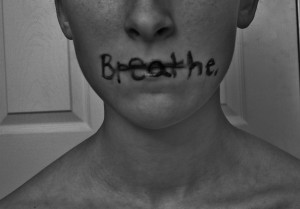I can be an incredibly irritable person from time to time. I get annoyed when people walk too slowly in front of me, when the fridge won’t close properly, and when I keep dying in Resident Evil at the same point. Usually, I’m able to control my anger and let it diffuse. But sometimes, I’m not. Like yesterday – when I tore off my running shoes and launched them with such force that they both left permanent dents in the wall, all while screaming obscenities at a volume that left my throat feeling raw.
There is a definite link between anger and anxiety. While they clearly feel different, they’re both states of heightened arousal. Both emotions often involve cognitive distortion and a biased evaluation of a situation. They both seem to involve the release of adrenaline and thus are manifestations of the fight-or-flight response. And from my personal experience, sometimes very acute anger can feel like a panic attack – the loss of control, the fear of going crazy, the shame that comes after you cool down.
Anger naturally would have us act aggressively. Perhaps our ancestors could lash out at a threatening foe, but our modern society does not grant us the outlets for acting aggressively (outside the realm of organized activities like sports). Instead, we have to learn to either suppress our rage or calm ourselves down. Suppressed rage can be a source of anxiety in itself, and sometimes it’s simply not possible to calm down (much as it’s impossible to calm down during a panic attack). Waiting until you lose control of your anger is probably not the best method. Instead, try thinking ahead.
How can you control your anger? There are no quick fixes, but here are some techniques I’ve picked up that help in the long run to deal with my anger and keep me more grounded and easygoing.
- Try relaxation. Whether it’s light stretching or mindfulness meditation, relaxation techniques are a good thing to pick up if you’re prone to anxiety or anger. From my experience with mindfulness, I can truthfully say that the more you practice being calm, the easier it gets. Learning the proper breathing techniques and tricks for keeping your mind focused on the present are great ways to keep yourself calm. Learn to do this while you’re feeling okay, and it will become easier to do when you’re not.
- Develop better communication skills. A passive-aggressive style of communication is a major source of anger and frustration for most anxious people. A common example of unhealthy passive-aggressive thinking is assuming that someone else should know what you want without actually telling them, and then feeling angry or cheated when they fail to meet your (silent) demands. Try to work on being more assertive – this way you will get your point across in a healthy way. I struggle immensely with being assertive, but I’ve been trying to work on it. It helps to start small: try buying a product and then returning it immediately. If you can master being assertive with strangers, move on to being assertive with your close friends and family. Getting your point across in a polite but direct fashion will save you hours of frustration.
- Use your journal. A great way to overcome your anger rationally is simply to document the things that make you upset and take a look at them once you’ve calmed down. Maybe you’ll be able to see patterns in the sorts of things that make you angry. Better yet, you may see that your anger is irrational and come up with a solution. Try restructuring the way you see the situation. For example, rather than honking and screaming at a driver who cuts you off, try asking yourself whether that person may be in some sort of emergency. Challenging your anger with rational thinking is a productive, healthy way to modulate your emotions.
- Exercise more often. Anger, like anxiety, is the product of pent-up emotional energy. Exercising is a great way to diffuse some of that energy. Go out for a jog or hop on your bike.
These are simply a few of the ways that you can learn to control your anger. Anger can strike out of the blue, sometimes in situations where you can’t easily diffuse it. Practice these techniques when you do have the ability to control your situation and it will get easier to handle situations that you can’t control.
How do you cope with anger? I would love to hear your own techniques.
[As a post-script, I just want to apologize for the sparse posting over the past week. My goal is to post at least twice a week, but I’ve been busy lately writing guest posts. You can read my guest post for Summer Beretsky’s blog Panic About Anxiety here, and you can read my two guest posts for the Free Your Mind Projects here and here. I will resume posting more regularly! I hope you’ve all had a fantastic week.]









